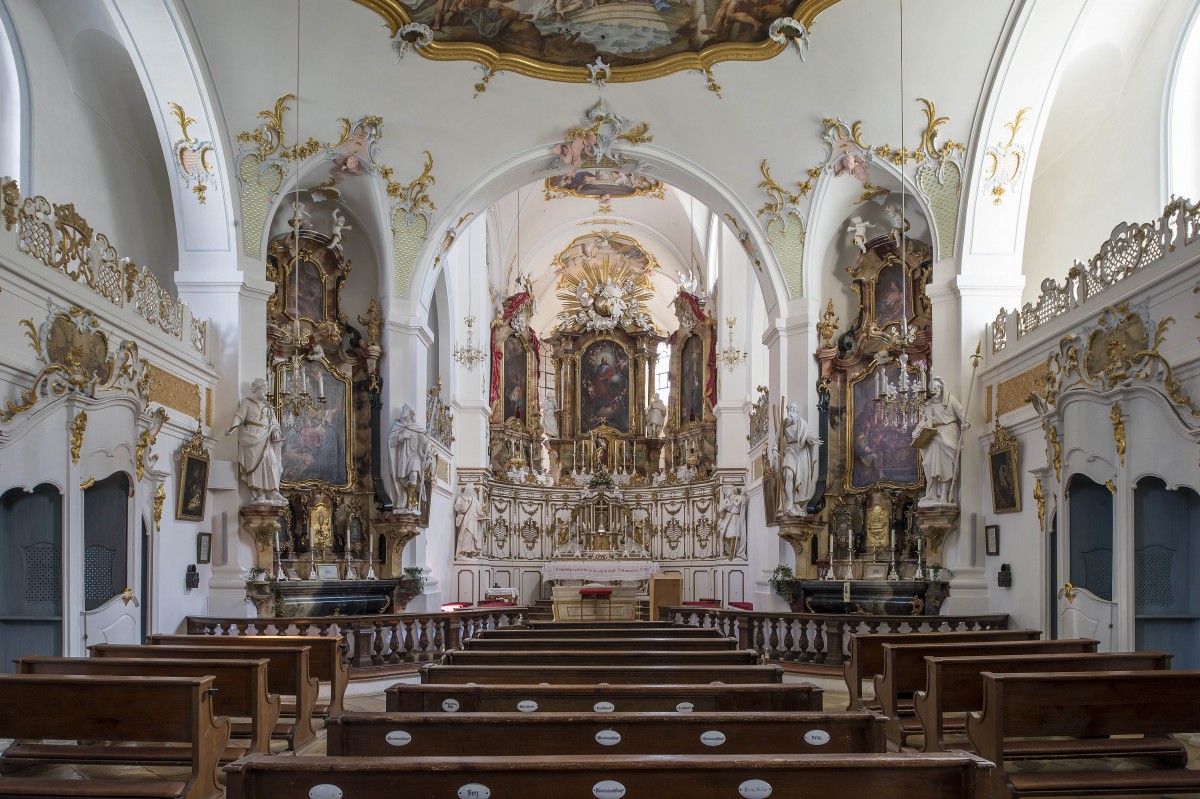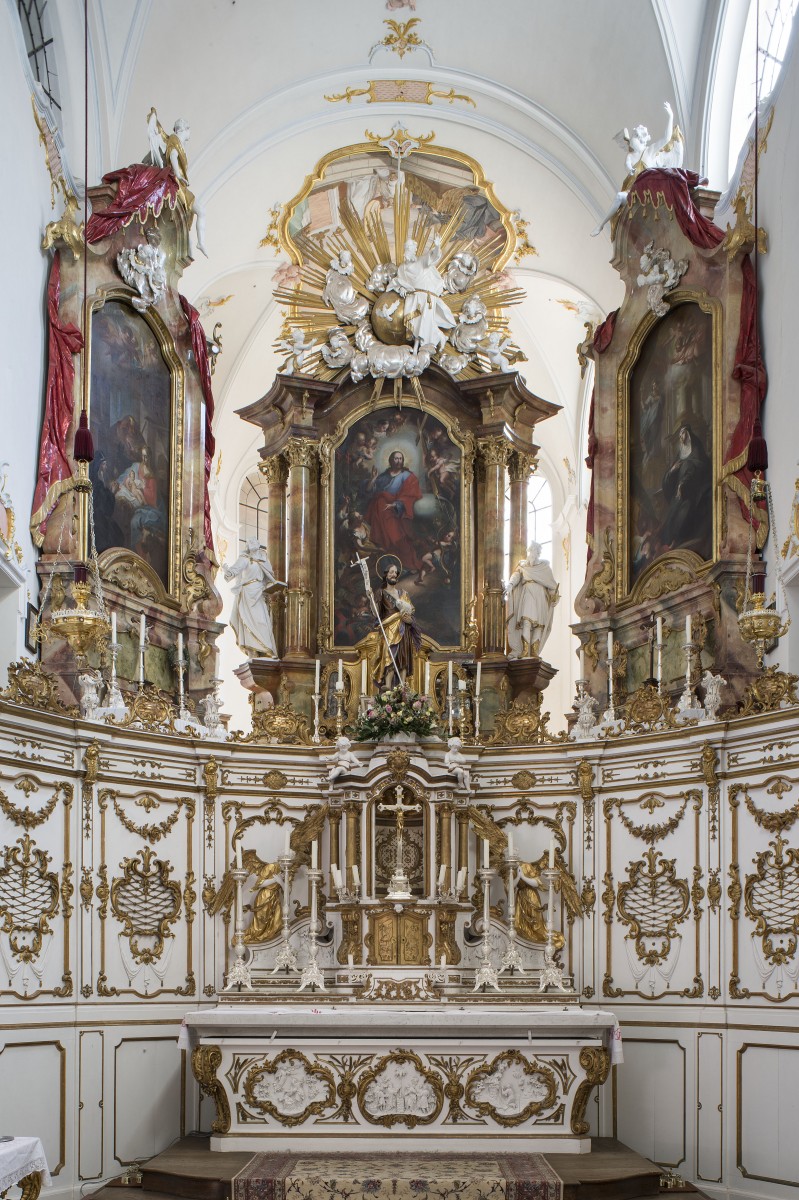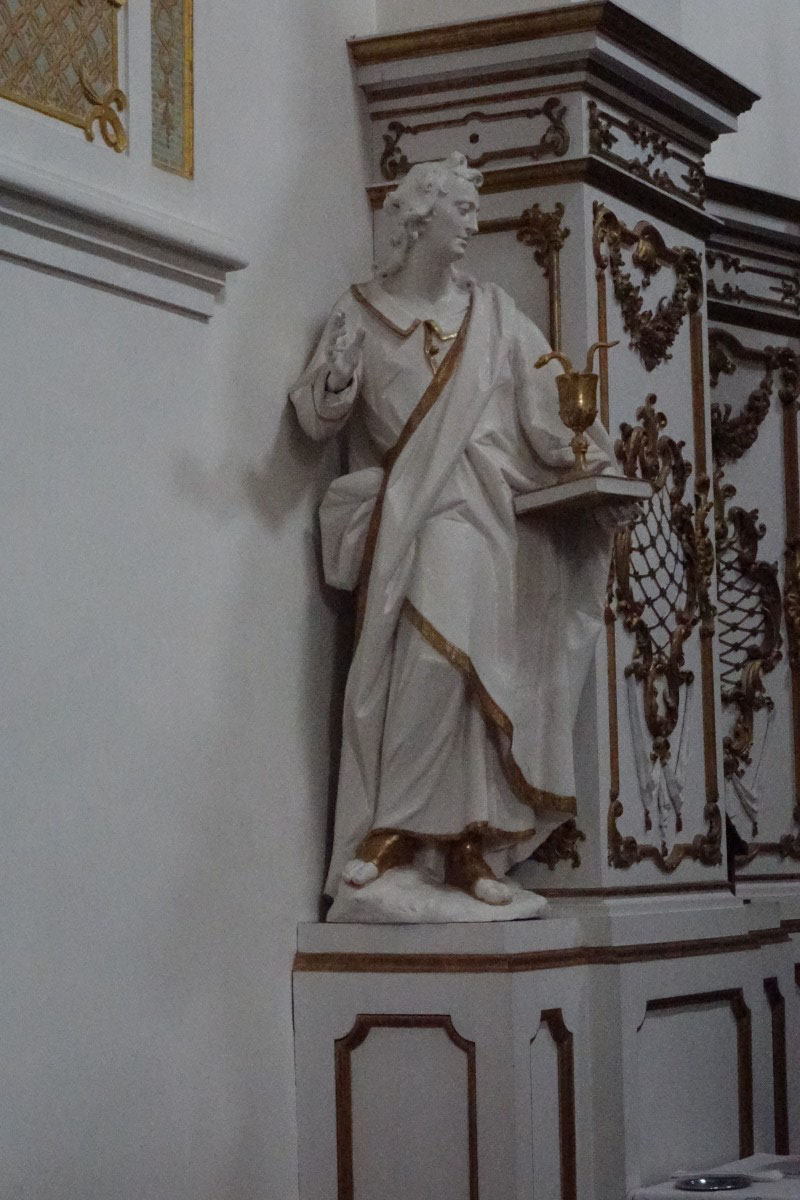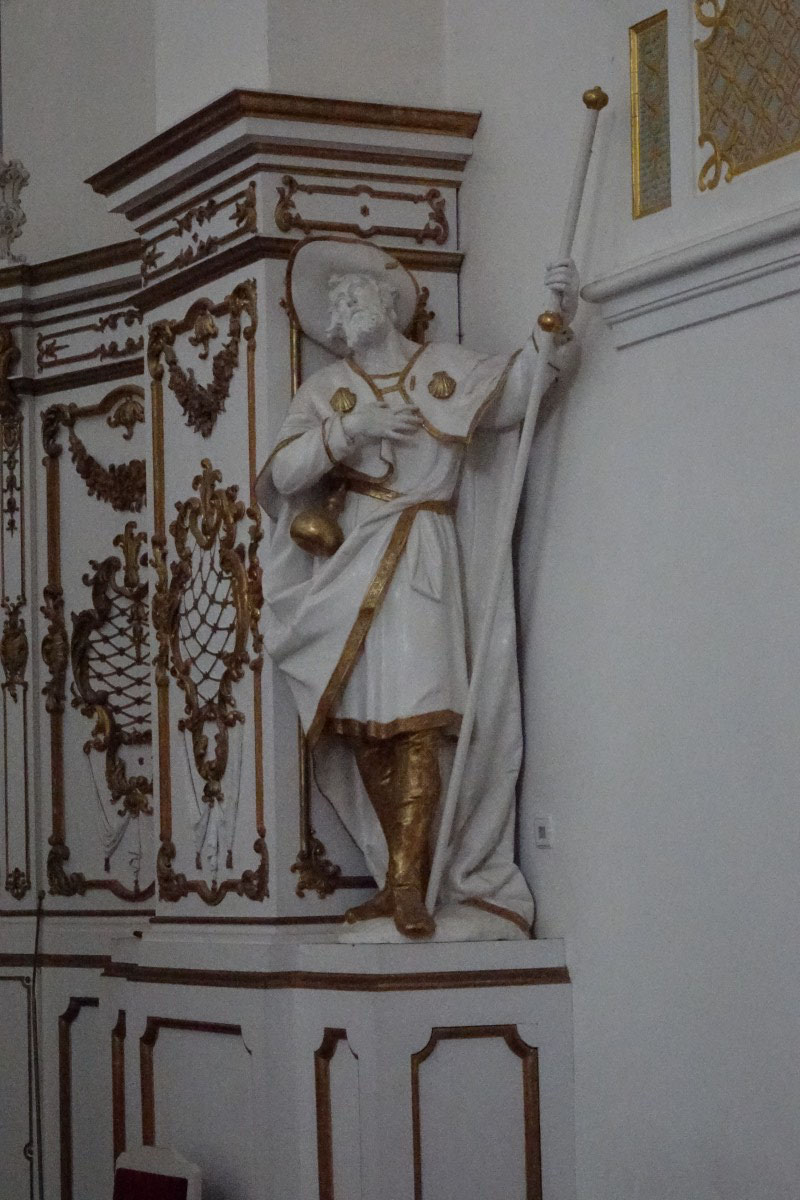Location
Germany, Bavaria, Altomünster
Former Monastery (now Parish) Church of St Alto and St Bridget (Ehem. Kloster- und heutige Pfarrkirche St. Alto und St. Birgitta)
Parish of St Alto and St Bridget
Artwork
High Altar of St Salvator in the Choir of the Parish and Former Monastery Church of St Alto and St Bridget in Altomünster
Type
High altar
Dimensions
Height: 874 cm, width: 433 cm
Critical History
J. M. Fischer began, in 1763, the construction of the church building. After his death (1766) his foreman Balthasar Trischberger continued Fischers work until 1771. C. Lippert registered under no. 61, in 1772, "six altars with nine large statues, geniuses and further sculptural decoration."1 Volk attributed the twelve statues of apostles and the sculptures of St Domenic and St Catherine of Siena, which belonged to the lower choir altar that was removed in 1883, to J. B. Straub. They are now in the BNM Munich (see order no. 3136). The church is equipped with nine altars. In total, Straub received 2.120fl (Volk said 1.400fl): on 20. November 1765, 300 fl (advance payment for the highaltar), in September 1766, 500 fl (altars in the eastern choir), in January 1767, 300 fl (for altars), in October 200 fl, in November 100 fl (altar in the main choir) in October 1768, 100 fl, in January 1769, 260 fl and in November 360 fl (St Alto and St Augustine altars, for each 360 fl). The cooperation with the carpenter Johann Mentele, Rain, and the painter and "Fassmaler" Ignaz Baldauf, Inchenhofen is documented. The canvas paintings on the three main altars can be lowered mechanically to present the skeletons of catacomb saints. The design for the two main altars left and right of the St Salvator altar, dedicated to St Bridget (canvas painting "Christmas vision of St Birgitta by Joseph Mages, 1767) and to St Catherine of Sweden (canvas painting „St Bridget honouring St Immaculata", 1767) were conceived by J. B. Straub but J. Mentele executed the work.2
The following altars were made by J. B. Straub and his workshop:
the high altar „St. Salvator“, painting "St. Salvator" by Ignaz Baldauf (1767), two standing sculptures of Sts Peter and Paul
the lower high altar (1883 removed), sculptures of St Catherine of Siena and St Dominic, now presented in the Bavarian National Museum (Inv.-no. 23/139 and 138)
further side altars:
St Wendelin altar, painting "St Wendelin" by J. Mages and two standing sculptures of St Bartholomew and St Thomas;
Holy Kinship altar, painting "Saint Family" by J. Mages, 1768, and two standing sculptures of St Andrew and St Mathew;
St Augustin altar with relief sculpture of St Augustin and two standing sculptures of St Philipp and St Jacmes the Less;
St Alto altar with relief sculpture of St Alto and 2twostanding sculptures of St Simon and St Judas Thaddeus.
The sculptures of St John and St James the Greater stand at both ends of the choir.
Sources: Documentation of the Archival Documents, M. Hildebrandt, Sabine John, Manfred Feuchtner, Stefan Nadler, 02.1998, Department ZIII, Documentation,Bavarian State Department of Monuments and Sites (BLfD)
Construction / Execution
The construction of the altar is in wood and has a polychrome paint layer (marbling). The paintings can be lowered mechanically to present the skeletons of catacomb saints. The sculptures are carved in wood and painted with a monochrome white layer and gilded details.
Components
- Carpentry
- Author: Johann Mentele
- Completed: 1765 – 1769
- Technique(s): sawing, wood carving
- Material(s): wood
- Sculpture
- Author: Johann Baptist Straub (Wiesensteig ca. 1704 – Munich 1784)
- Completed: 1765 – 1769
- Technique(s): wood carving
- Material(s): wood
- Polychromy
- Author: Fortunat Strasser
- Completed: 1765 – 1770
Comment
In the monastery chronicle, in a document from 1770, Fr. Fortunat Strasser is mentioned for his careful and diligent work on the polychromy of the altars.
The sculptures carved by J. B.Straub's own hands show the same high quality on the front and reverse sides. On the high altar of St Salvator the board which covers the hollowing on the reverse sides of the sculptures of St Peter and St Paul is just flat, even though there is a painting "Mary's Assumption", a tebernacle and pews for holding mass on the back side of the altar.
Conservation-restoration
- 1871
Treatment Description
Renovation by Ludwig Hack, Dorfen.
- 1883
Treatment Description
The lower high altar was removed and replaced by a new one. Two sculptures, of St Catherine of Siena and St Domenic, are today part of the sculptural collection in the Bavarian National Museum. (Inv.-no. 23/139 and 138). see order: 3136.
- 1907
Treatment Description
Renovation by Ludwig Ametsberger.
- 1928
Treatment Description
Removing the overpainting from the 19th century and the monochrome white layer from the 18th century. On the relief-sculptures of St Alto and St Augustine the 18th century polychromy was removed partially. Reconstruction of the 18th century polychromy.
- 2000
Treatment Description
Consolidation of wood and polychromy. Uncovering of the 18th century polychromy, reintegration of lacunae, retouching, partially reconstruction of the 18th century polychromy.
Images
- The high altar of St Salvator in the Parish (former Monastery) Church of St Alto and St Bridget, Altomünster (Bavarian State Department of Monuments and Sites, photo by Michael Forstner, 2017)
- The high altar of St Salvator in the Parish (former Monastery) Church of St Alto and St Bridget, Altomünster (Bavarian State Department of Monuments and Sites, photo by Michael Forstner, 2017)
- The sculpture of St John in the choir of the Parish (former Monastery) Church of St Alto and St Bridget, Altomünster (Bavarian State Department of Monuments and Sites, photo by Rupert Karbacher, 2019)
- The sculpture of St James at the choir of the Parish (former Monastery) Church of St Alto and St Biridget, Altomünster (Bavarian State Department of Monuments and Sites, photo by Rupert Karbacher, 2019)
Catalogue entry prepared by Rupert Karbacher
Recommended citation: Rupert Karbacher, High Altar of St Salvator in the Choir of the Parish and Former Monastery Church of St Alto and St Bridget in Altomünster, in: TrArS – Tracing the Art of the Straub Family, 2018, (accessed 25/10/2025) URL




